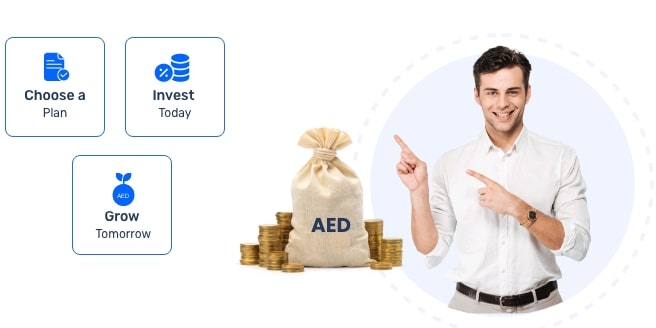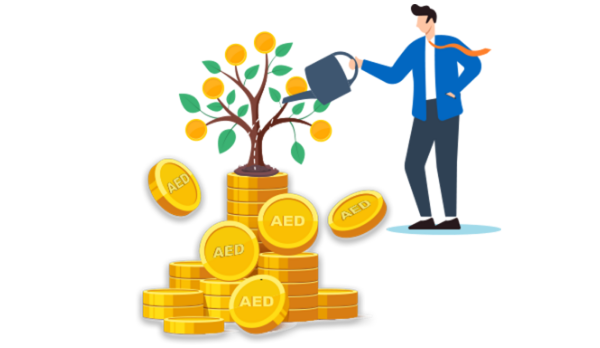How to Get a Passive Income From An Investment in UAE?
Invest smart today for a better tomorrow
If you are someone who is looking to achieve financial independence along with well-being, having a passive income is a must for you.
Instead of being someone who waits to receive some sort of income at the time of retirement, you should be wise enough to invest in those assets that can supplement your existing income or profits.
The following are the 3 broad types of income that one can generate based in the UAE:
- Active Income or Earned Income
- Income from Investment in UAE – Portfolio Income or Capital Gains
- Income from Investment in UAE – Passive Income or Cash Flow
Earned Income
- Any income that you receive in the form of a salary, fees, profit, gambling or from any sort of activity that requires you to put in your effort and time is known as an Active Income or an Earned Income.
- This form of income is produced when one is at work.
- This income inflow stops when one stops working, or in worse situations is unable to work due to health-related reasons.
- This type of income is in direct proportion with the amount of time that is spent by you at work and in developing your skills.
- It is quite tough to increase your active or earned income without you working for longer hours or without know acquiring any sort of new knowledge or skill.
- Despite the challenges that are involved in this sort of income, a majority of the population out there depends largely on earned or active income, for the main reason that it does not require an injection of any capital.
Income From Investment in UAE – Portfolio Income or Capital Gains
- Portfolio income or capital gains is a sort of income that is generated by the sale of an investment in UAE at a price that is higher than the price that was paid initially for the same, plus the costs that are involved in maintaining the asset to keep it in a resaleable quality.
- For instance, if a salaried individual bought a property that is worth AED 1,000,000 and on top of which he has incurred expenses worth AED 50,000 towards registration charges, maintenance, interest, and mortgage fee before he sold the same property in 3 months for the price of AED 1,100,000 – his portfolio income from such a transaction would be worth AED 50,000.
- This income is generally generated by trading of the assets that are invested for the purpose of making a profit from sale in the future.
- Some examples of investment in UAE for portfolio income are:
- Trading i.e., buying and selling Bonds, Stocks, Mutual Funds, Sukuks (ADX, DFM, and International Markets), Currencies, Commodities, and other types of Derivatives or Futures.
- Selling and buying Real Estate. The properties in the UAE provide an ideal environment for one to benefit from the volatilities of the prices of the property in the short and medium runs. However, this can be a risky proposition.
- Buying and selling any other sorts of assets such as art, antiques, watches, cars, and other collectibles.
Challenges Faced With The Portfolio Income
When you think of pursuing the portfolio income you will face the following challenges:
- Capital Risks: You are required to have a lot of knowledge as well as experience in order to learn how to analyze risk along with achieving optimal asset allocation and building a portfolio that is robust.
- Time Taking: The portfolio income that one earns via trading of paper assets requires a lot of time and effort to be put in when it comes to keeping a constant update on the macro as well as microeconomic developments occurring across the globe.
- Liquidity Risk: There can be a degree of illiquidity involved in a property portfolio. This leaves very little room for rebalancing the portfolio as per the response to the changes in the market.
Advantages of Portfolio Income
Despite the challenges involved in this income stream mentioned above, portfolio income definitely has an advantage over the earned income. It allows the investor to take advantage of the power of compounding when he or she is investing for a period ranging from medium to long term. Once you have become an investor with sufficient knowledge along with experience in the treading of paper and tangible assets on a regular basis, it can help you in enhancing your financial well-being in a faster manner. Such income can end up catapulting your wealth to a great extent.

Income From Investment in UAE – Passive Income or Cash Flow
The regular cash flow that is generated from activities that require very little or absolutely no effort is known as passive income. Generally, it is the cash flow that is generated via the assets that are owned by an individual. Below are some of the passive income ideas from an investment in UAE:
- Rent: The falling prices along with the surge in affordable housing options in the UAE have caused the rental yields to go up. It would be wise for an investor to consider investing in a rent yielding property located in the UAE.
- Dividend Investing: Dividend received from stocks (ADX, DFM, or International Markets) is a great mode of cash flow for an investor.
Advantages of Passive Income Investment in UAE
There are some major advantages associated with passive income as compared to the other two sources of income, such as:
- Passive income is usually like a recurring income stream. Although, it does require one to put in some efforts, capital, and especially knowledge to set it up.
- Once you have established your source of passive income, it does continue for a foreseeable future, or at least till the asset is worn out or sold. This is an ideal source of income for someone who is aiming at achieving financial independence or retirement.
- The passive income streams such as rent tend to grow with inflation.
- It eradicates the need to actively buy and sell assets. Instead of this, it shifts one’s focus on the income yielded by the asset. You can also initiate to sell this asset at a price that is higher at a later date in the future when the capital gains seem to outweigh the regular income yielded.
Challenges Faced With Passive Income
Considering the benefits mentioned above, many expats are now interested in building a portfolio consisting of assets that provide them a passive income. However, there are some challenges faced with this source of income also, such as:
- Lack of capital that is needed to invest in assets that generate a passive income due to the high initial investment or down-payment that is involved.
- Insufficient knowledge, time, and skills that are required for one to create and manage a portfolio that is robust.
- Shortage of dependable people to take advice from in this investment avenue.
Capital Accumulation
Accumulating sufficient capital that will help you invest in assets that generate a passive income is the first and foremost step that is important to be taken. You are required to have a critical mass as investable capital in order for you to generate sufficient passive income.
It is as simple as it gets, the most effective and efficient strategy for the accumulation of capital is to start saving from the active income you receive.
More From Investment
- Recent Articles
- Popular Articles



















